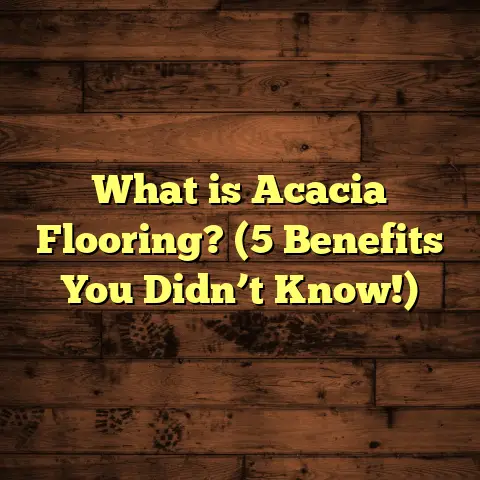What is a Pickled Floor? (5 Must-Know Benefits for Homeowners)
Have you ever stepped into a room and felt something different beneath your feet? Like the floor itself was telling a story—something subtle, yet captivating? That’s the kind of feeling I chase as a flooring contractor. Over the years, I’ve worked with all sorts of finishes and styles, but one technique that always stands out is the pickled floor. It’s a finish that has quietly grown in popularity among homeowners and designers alike. You might have caught glimpses of it in trendy homes or lifestyle magazines but wondered, what exactly is a pickled floor? Why are people choosing it? And what does it bring to a home?
I’ve worked on dozens of projects featuring pickled floors, from cozy cottages in Oregon to urban lofts in New York City. Along the way, I’ve gathered a ton of insights—some technical, some personal—that I’m excited to share with you. So grab a cup of coffee and let’s explore what makes a pickled floor so special.
What Is a Pickled Floor?
Let’s start with the basics. What is a pickled floor?
In simple terms, a pickled floor refers to hardwood flooring that has been treated with a special white or light-colored stain known as “pickling.” This stain is designed to enhance the wood’s natural grain by filling it with white pigment, creating a pale, washed-out look that brightens the surface while allowing the texture and patterns of the wood to show through.
Think of it like this: you take beautiful natural wood—say oak or pine—then you apply a translucent whitewash that softens its color but keeps its character. The result is wood that looks lighter and airier than traditional hardwood floors but still feels organic and warm.
The Process Behind Pickling Floors
Pickling isn’t just slapping some white paint on wood. It’s a carefully controlled process involving several steps to get the right look and durability. Here’s how I usually approach it when finishing floors:
- Preparing the Substrate:
First off, the floor needs to be completely bare. That means removing any old finishes, varnishes, or stains by sanding down to bare wood. For pickling, sanding between 120 and 150 grit works well. This level of sanding keeps the wood smooth without closing its pores. - Choosing the Right Pickling Solution:
Pickling stains are typically water-based and contain titanium dioxide or other white pigments. Some brands allow you to adjust opacity by adding water or layering applications for a lighter or heavier look. - Applying the Pickling Stain:
The stain is applied evenly with a brush or rag. It’s important to work in small sections because you want to control how much pigment penetrates the grain. After application, you let it sit for about 5 to 10 minutes—this lets the pigment soak in before wiping off excess. - Wiping and Drying:
Once the stain has soaked in, you wipe off what’s left on the surface with a clean cloth to avoid chalkiness or uneven finish. Then, the floor needs to dry completely—usually about 4 to 6 hours, depending on humidity and temperature. - Sealing for Protection:
Finally, a protective topcoat is applied. Polyurethane (either oil- or water-based) is common for durability, but hardwax oils can also be used for a natural finish. This step ensures your pickled floor stands up to daily wear for years.
What Wood Species Work Best?
Not every wood species reacts the same way to pickling stains. In my experience, some woods are better suited due to their grain structure and natural color.
- White Oak:
Its pronounced grain lines take the white pigment beautifully and create striking contrast. White oak is also durable, making it a popular choice for high-traffic areas. - Red Oak:
Slightly warmer than white oak but still receptive to pickling; results tend to be softer and less stark. - Pine:
Pine absorbs stains unevenly due to its open grain but can produce a charming rustic look with pickling when done carefully. - Ash:
Ash has a grain similar to oak but lighter color naturally, making it great for an airy effect. - Maple:
Harder to pick because of its tight grain; often requires special preparation or multiple coats.
Pricing Breakdown — What Does Pickled Flooring Cost?
When clients ask me about cost, I like to give them detailed numbers based on their project size and location because prices vary widely.
- For professional pickling (including sanding, staining, sealing), costs generally range from $4 to $7 per square foot.
- For example: A 500-square-foot living room will likely cost between $2,000 and $3,500.
- Additional prep work (like repairing damaged boards) can add $500–$1,000.
- DIY kits are available starting at around $50 to $150 for smaller areas but require skill and patience.
In cities like New York or San Francisco, labor costs push prices higher—sometimes up to $8 per square foot—due to demand. Rural areas may offer lower rates but fewer specialists familiar with pickling techniques.
Why Pickled Floors? 5 Benefits Homeowners Should Know
Over the years, clients have given me plenty of reasons why they chose pickled floors. Let me share five key benefits that often come up.
1. Brighten Up Your Space Without Losing Wood’s Character
If you want lighter floors but dislike flat white paint or laminate flooring’s plastic feel, pickled floors offer a sweet spot.
The white pigment reflects light beautifully but leaves wood grain visible—it’s like turning up the brightness on natural wood without washing it out.
I remember working on a mid-century modern home in Seattle where dark walnut floors made rooms feel closed-in. After pickling those floors with a very light coat, the space felt open and welcoming without losing warmth.
According to research by Zillow, homes with lighter wood floors sell faster because buyers perceive them as more spacious and modern. In fact, homes with light-colored flooring can appear 15-20% larger visually.
2. Hide Years of Wear and Tear
Older hardwood floors often have scratches, dents, or discoloration from pets, furniture moves, or sun damage.
Pickling cleverly camouflages these imperfections because the white stain softens contrast between damaged areas and intact wood.
One case stands out: I refinished floors in a 1920s Victorian home where the floors were beat up from decades of use. After pickling and sealing, my client said she couldn’t believe how “all those ugly marks disappeared but you could still see every groove.”
3. Versatile Style That Works With Many Décor Themes
Whether your aesthetic is coastal cottage, rustic farmhouse, Scandinavian minimalism, or urban industrial loft—pickled floors fit right in.
They provide a neutral base that pairs well with natural fibers like linen or jute rugs and contrasts nicely with bold colors and metals.
I recently helped three clients with pickled floors who all loved how adaptable they were:
- A beach house owner chose pickled pine for lightness.
- A city dweller went with pickled ash for an edgy vibe.
- A suburban family picked pickled oak for warmth with modern flair.
This versatility means your flooring won’t look dated quickly—a key factor in long-term satisfaction.
4. Eco-Friendly Finishes Are Available
Many homeowners today care about indoor air quality and environmental impact—me included.
Pickling stains are often water-based and low-VOC (volatile organic compounds), meaning safer air during application and afterward.
Brands like Bona and General Finishes offer certified low-VOC pickling stains that meet strict environmental standards.
Choosing these products supports healthier homes without sacrificing style or durability.
5. Boost Your Home’s Value and Appeal
Real estate professionals consistently say hardwood floors increase home value—and unique finishes like pickling add extra interest.
A survey by the National Association of Realtors found hardwood floors raise property value by 2-5%, depending on condition and style.
In Austin, Texas, one client installed pickled oak throughout their open-plan living area before putting their home on the market. They received multiple offers above asking price within two weeks—a strong sign buyers appreciated the unique look.
My Personal Flooring Stories: Real Projects With Pickled Floors
Over many years in this business, I’ve been lucky enough to work on some amazing homes featuring pickled floors—and each project taught me something new about this finish’s potential.
The Seattle Craftsman Revival
One memorable job was a 1910 Craftsman home near Lake Washington. The original fir floors were in rough shape—deep scratches, uneven color from years of neglect.
The owners wanted something fresh but wanted to keep the home’s historic feel intact.
After stripping back to raw wood and applying three layers of white pickling stain with a protective satin polyurethane topcoat, the transformation was stunning.
The floor had this soft white glow that made their dark wood trim pop beautifully. They said walking on it felt like “stepping into history with a modern twist.”
Coastal Cottage in Cape Cod
Another favorite was a beach cottage renovation in Cape Cod where owners wanted light floors that could withstand sand, salt air, and heavy foot traffic from kids and pets.
We selected pine flooring for its character and applied a durable water-based pickling finish sealed with hardwax oil for extra moisture resistance.
The result was bright, resilient floors that fit perfectly with soft cream walls and navy accents.
They told me their friends always comment on how “the floors feel fresh yet lived-in,” which is exactly what they wanted.
Urban Loft in Brooklyn
In Brooklyn’s Williamsburg neighborhood, I worked on an industrial loft conversion where owners chose ash hardwood floors with a light pickled finish that complemented exposed brick walls and metal fixtures.
They wanted something edgy but not cold—something that balanced raw urban elements with warmth.
The pickled ash achieved that balance perfectly—keeping the loft bright while adding texture underfoot.
Going Deeper: Technical Aspects of Pickled Floors
Let’s talk specifics that matter if you’re thinking about doing this yourself or hiring pros:
Drying Times & Environmental Factors
Water-based pickling stains dry faster than oil-based ones—typically within 4–6 hours under normal conditions (70°F/21°C at 50% humidity).
High humidity slows drying; very dry environments speed it up but can cause faster evaporation leading to uneven absorption if not careful.
Durability & Longevity
Properly sealed pickled floors can last over 10 years before requiring refinishing.
Polyurethane topcoats offer excellent abrasion resistance; hardwax oils provide natural matte finishes but need more frequent maintenance (~every 2-3 years).
Maintenance Tips
Avoid harsh cleaning agents like bleach or ammonia-based products—they can strip away white pigment or dull sealers.
Stick with pH-neutral cleaners designed for hardwood floors—damp mopping works best.
Use area rugs in high-traffic zones to minimize wear.
Coverage & Waste Factors
A gallon of pickling stain covers roughly 300–400 sq ft, depending on wood species porosity and application method (brush vs rag).
Expect 5–10% extra material for overlapping coats or touch-ups.
Is Pickling Right For You? Questions To Ask Yourself
Before you decide:
- Do you want brighter floors without losing wood grain texture?
- Are your current floors worn but salvageable?
- Do you prefer neutral tones that fit many styles?
- Is indoor air quality important? Would low-VOC finishes appeal?
- What’s your budget and timeframe?
Comparing Pickled Floors With Other Finishes
How does pickling stack up against other popular options?
| Finish Type | Appearance | Maintenance | Cost / sq ft | Durability |
|---|---|---|---|---|
| Natural Hardwood | Warm tones; varies by species | Moderate cleaning | $3–$8 | High |
| Stained Hardwood | Rich color options | Moderate | $4–$9 | High |
| Pickled Hardwood | Pale whitewashed look | Gentle cleaning | $4–$7 | High |
| Laminate Flooring | Imitates wood | Low | $1–$3 | Moderate |
| Vinyl Plank Flooring | Wide styles/colors | Very low | $2–$5 | Moderate |
Pickling offers a unique style that falls between natural wood’s warmth and painted floors’ brightness without sacrificing authenticity or durability.
Case Study: A Homeowner’s Journey With Pickled Floors
Let me share Emily’s story from Portland, Oregon:
Emily bought an older bungalow with original oak floors worn dull by decades of pets and kids running around. She wanted something bright but didn’t want carpet or laminate because she loved natural wood texture.
We discussed options and decided on pickling after testing samples in her living room under different light conditions. The project took two days: one day sanding and applying stain; day two sealing after drying overnight.
Emily told me afterward:
“I can’t believe how much lighter my house feels! The floors still show their character but brighten everything up—it’s exactly what I was hoping for.”
She estimates she saved about $1,000 compared to replacing floors entirely—which also meant preserving original charm she loved.
Final Thoughts: What Makes Pickled Floors Worth Considering?
To wrap up my thoughts (and hopefully yours too):
Pickled floors balance beauty and function expertly. They brighten rooms naturally yet keep wood grain alive; hide imperfections while aging gracefully; blend into various décor styles; offer eco-conscious finishes; and increase home value subtly but surely.
If you want a flooring finish that’s both timeless and fresh—a look that isn’t just a trend but one that ages well—pickling deserves serious attention.
And remember: good results depend on proper sanding, quality products, skilled application, and protective sealing.
Drop me a line anytime if you want help sourcing materials or finding trusted contractors near you—I’m here to make your flooring dreams real!
So tell me: Have you seen pickled floors before? What did they feel like? Are you thinking about trying this technique yourself?





